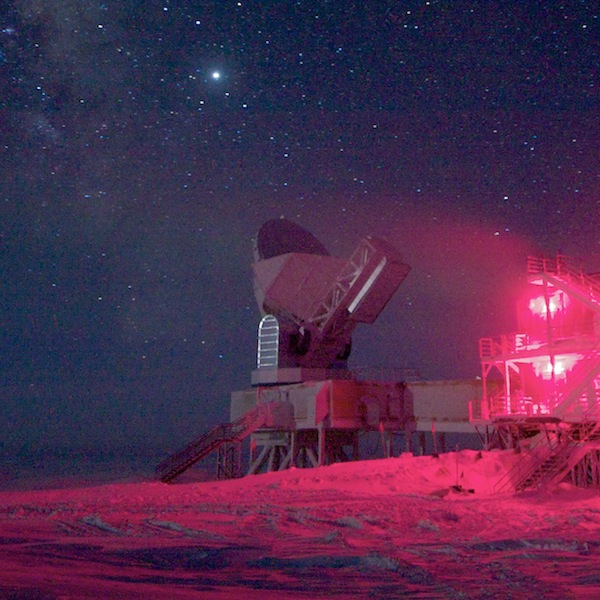Dunlap Institute’s Keith Vanderlinde recipient of John R. Evans Leaders Fund award
Professor Keith Vanderlinde of the Dunlap Institute for Astronomy & Astrophysics is one of 44 University of Toronto scientists being awarded over $12 million in funding from the Canada Foundation for Innovation’s John R. Evans Leaders Fund.

South Pole Telescope Image: Keith Vanderlinde
The John R. Evans Fund, formerly named the Leaders Opportunity Fund, supports universities in acquiring infrastructure that allows faculty to conduct ground-breaking, innovative research.
Vanderlinde’s funding will go toward establishing the Dunlap’s Long-Wavelength Instrumentation Laboratory. The lab will enable the testing and development of microwave detectors destined for the South Pole Telescope, and radio technologies critical to a new generation of digital telescopes.
“By studying large-scale structure within the Universe,” says Vanderlinde, “we can track both the evolution of that structure and the accelerating expansion of space.”
“That acceleration, driven by a previously-unknown ‘dark energy’, is one of the most significant discoveries of modern cosmology,” explains Vanderlinde. “This infrastructure will help develop long-wavelength instrumentation technologies, making future observations ever-more precise. It will help build our understanding of the mysterious dark energy that seems to permeate and dominate our Universe.”
The funding will go toward two primary systems of infrastructure necessary to enable Vanderlinde’s research at the Dunlap.

Prof. Keith Vanderlinde Image: Dunlap Institute for Astronomy & Astrophysics
The first is a cryogenic environment for cooling microwave detectors to -273C, as well as equipment for testing the detectors. The second system comprises a radio-correlator and radio-generation and analysis test bed—equipment that will allow the development and testing of technologies required by a coming generation of “digital” telescopes.
Vanderlinde joined the Dunlap Institute in January 2013 from the McGill Cosmology Instrumentation Lab in Montréal. Previously, he spent most of 2008 in the Antarctic as a “winter-over” for the South Pole Telescope at the Amundsen-Scott South Pole Station. He received his PhD at the University of Chicago.
He is a member of a cross-Canada collaboration building the Canadian Hydrogen Intensity Mapping Experiment, an innovative radio telescope near Penticton, B.C. that will create a three-dimensional map of a larger volume of the Universe than ever previously attempted.
He continues to conduct research using the South Pole Telescope, and is part of a team making Very Long Baseline Interferometry observations of pulsars using a global array of radio telescopes, including the Algonquin Radio Observatory in Northern Ontario.
-30-
CONTACT INFORMATION:
Prof. Keith Vanderlinde
Dunlap Institute for Astronomy & Astrophysics
University of Toronto
e: vanderlinde@dunlap.utoronto.ca
p: 416-946-5436
http://dunlap.utoronto.ca/~vanderlinde/
Chris Sasaki
Public Information Officer
Dunlap Institute for Astronomy & Astrophysics
University of Toronto
e: csasaki@dunlap.utoronto.ca
p: 416-978-6613
The Dunlap Institute for Astronomy & Astrophysics, University of Toronto, continues the legacy of the David Dunlap Observatory: by developing innovative astronomical instrumentation, including for the largest, most advanced telescopes in the world; by training the next generation of astronomers; and by fostering public engagement in science. The research of its faculty and postdoctoral fellows includes the discovery of exoplanets, the formation of stars, galactic nuclei, the evolution and nature of galaxies, the early Universe and the Cosmic Microwave Background, and the Search for Extra-terrestrial Intelligence (SETI).
###
